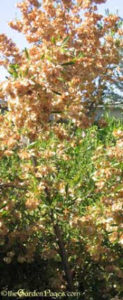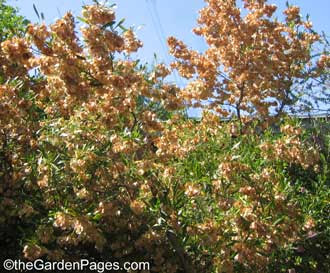I have been profiling a number of drought tolerant, fast growing screen plants lately and Dodonaea belongs on the list too. These lacy shrubs are also called Hop Bush or Hopseed Bush after their seed pods that resemble hops. Hop Seed bushes come with leaves in either bright, lime green or dark purple. Both versions have leaves about 4 inches long and 1/2 inch wide and are very shiny on multiple shrubby branches. In Los Angeles the hot sellers are purple. I of course, am partial to the green ones.
Some Dodonaea are native to Australia, but Dodonaea viscosa is native to the Western US and Hawaii. The Zone breakdown for Dodonaea viscosa is: USDA Zone: 9-11, and Sunset Zone: 7-24.
These drought tolerant shrubs are fast growers to about 10 feet tall and almost as wide. They take full sun to part shade. Once established in the garden (1-2 years) they can survive on rainfall alone.
Hopseed bushes have a growth habit that is a bit airy, with lots of small branches and the long leaves adding to the lacy feel. They can be trimmed as hedges or espaliers for a slightly denser effect or pick one strong branch to train them as a tree. Dodonaea are good for layering in the landscape, to create a full, lush feel in the border.
Hopseeds are perfect for the back of the bed (where the sprinkler won’t reach), along fences or as border screens. You might try planting a few of these to wall off a secluded garden room in the back yard. In late spring they develop large, papery seed pods, usually light brown, which hang on for weeks and rustle in the breeze. Create a little resting spot near them so you can listen to their rushing whisper and calm down after a long day.

Although the seed pods break down quickly in the soil, I do not recommend planting these bushes near pools or any other place where neatness counts.
About four years ago I planted three large green Hopseeds and a smaller purple shrub. All four were in one gallon pots. I asked my nursery guy for the biggest one gallons he had but one of them had to be purple (I had to see what the fuss was all about). I wound up with a small purple and three large green plants which probably weren’t selling so fast. Fine. I was happy to get the less popular green ones because they were already big. I wanted to screen off a big chunk of the chain link fence out back and fast. The green Dodonaeas were a little rootbound, but off to a good start.
After four years the green hopseeds have grown to over eight feet tall and about six feet wide. They can get up to 15 feet high and as wide. My purple Hopseed is still thin; only about six feet tall and has only spread to about four feet. The plants are growing near each other, get the same amount of water (not much) but a bit less sunlight. Perhaps that is why the purple Dodonaea is lagging in the growth department. My Sunset Western Garden Book tells me that the purple and bronze cultivars also need more sun to keep their color.
The purple Hopseed sort of recedes into the back of the bed, creating a dark shadowy shape. It would be a great effect if you want to create some mystery in your garden: what’s back there? is a secret chamber hidden behind those leaves? The green Hop Shrubs in contrast, are very lacy, willowy and stand out. They have grown through the shrubs next to them and I like the wild effect of having bright green sprigs waving in the breeze.
Nether color Hopseed creates a solid screen the way a brush cherry can. You can sort of see through them if you try. But they’re pretty , drought tolerant and fast growing. Think of them as green lace curtains for your garden. Here are a few photos for you to enjoy. Happy gardening!

Best of luck if you're considering adding these to your yard. Here's my personal story.
I purchased a home in South OC and needed to establish privacy for my (sadly) typically small backyard. Narrow beds running along two lot lines; some full sun, some part sun, some mostly shade. After much research, I went with the purpurea (purple turning) variety. Planted 20 5gallon containers, 5 feet on center bordering my fence. They were cheap — I want to say $8-10 from a nursery in Oceanside. (Armstrongs and my favorite Plant Depot quoted me something like 3 times this so call around). This was Oct/Nov 2010.
As of Jan 2012, they've thrived. In less than 18 months, they've gone from a scrawny ~5' tall and 2' wide size to a full ~8' tall and 4' wide. It’s pretty amazing how they’ve performed so quickly. I wish I could upload a before and after photo. I’m being conservative with my numbers.
I put them on drip irrigation their first year — as-often as I needed to keep their rootballs moist while getting established that fall/winter and spring. During their first/only summer, they got watered 2x/month. I’ve read they can survive on rainfall alone since they’re native. This summer I’ll cut back to 1x/month and compare the results. I’m 80% completed with my goals to provide screening; another year and then I want them to slow down (live longer). After this summer, I’ll probably stop watering them.
I'm surprised I don't care very much about how mine change color. For those who don’t know, the same plant — Dodonaea viscosa – has a purpurea variety. They’re both a kind of lime green, but with purpurea, the leaves turn purple for a couple of months. Mine have already mostly turned back green (it’s Jan), so it might have been an Oct/Nov/Dec thing. I can take it or leave it. (No pun intended.) Honestly, I didn’t plant these because I think they’re beautiful. They’re functional and have the least amount of baggage for those I considered.
I also found that some flower. I assume it’s a male/female thing because it’s not all of them. They’re almost unnoticeable, like dried out seeds. The images they show for Dodonaeas often are of plants flowering much more than any of mine do. They’re just a green leaved bushy shrub that happen to seed for a small window here in S. OC. – not a wall of flowers or anything.
They shape well with hand pruners. I’ve discovered that I can keep them as narrow or wide as I want. I’m not sure how tall they’ll grow. I’ve read they’ll go anywhere from 8’ to 12-15’. Mine are blowing through 8’ with no sign of slowing down.
I had to remove the stakes that came with the containers and replace with nylon straps loosely screwed into my fence. Dodonaea grow fast and eventually pull out the stakes. I went down the path of replacing the original ones with nice/taller stakes, but straps are better, cheaper, and easier for my situation.
Again, best of luck. So far, mine have proven great and accomplishing my goals. They’re not trophy trees, but they’re great screen shrubs for the Mission Viejo/RSM/SJC area. I’ve seen them thrive in Corona Del Mar, too.
Perhaps you can help. I have a 6 to 8 year old multi-trunk Jacaranda. It gets direct sun with a Southern exposure. It has never produced on purple flower. I read that it might be the wrong sex, but then full researched it and found that they dioceious (bisexual). then I read that they come from an area in Africa that has a winter drought. Perhaps I should let it suffer from a manufactured drought for 5 weeks or so? Any thoughts?
Thanks, I hope you will answer and you seem to be knowledgeable. I made a major purchase of 20 15 gallon purple hopseed. These were in "tree" form, about 9 feet tall and 2 feet wide. I want them to grow denser and wider, not taller. I read that they grow to be 10 x 10, but that doesn't seem right. I planted them for a screen and set them 5 feet apart expecting that if they grow 5 ft wide, I will get double density. Does that sound right? Also, I would like to top them a foor or so to stimulate side growth. Do you think the topping idea will work?
I love this plant, but I had to take ours back to home depot because I found out they are not the best choice if you're in a high fire risk area. They would have been great to hide the neighbors, otherwise.
Thanks for shedding light on Dodonea, I just placed it at a clients house to hide an ugly pink block wall, knowing that they would not maintain it or water it much….thank goodness it needs neither!